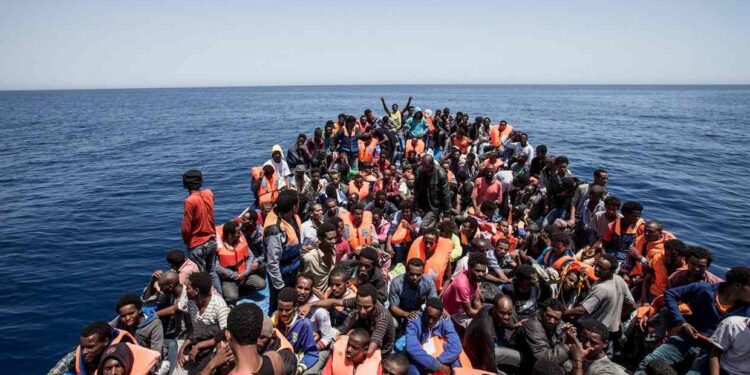In late August 2024, the BBC carried a story about how a 50-year-old Senegalese, named only as Amina, said: “I found out that my son had died on social media.” That son, 33-year-old Yankhoba, had perished on the Atlantic Ocean as he sojourned to Europe in search of a better life. His body was found on the other side of the Atlantic Ocean, about 18km (11 miles) off the coast of the Dominican Republic, the BBC reported. He was on the perilous journey with 13 others, who were mostly from Senegal, Mauritania and Mali, according to local police accounts. They presumably were trying to reach the Canary Islands on the wooden fishing boat often used to transport illegal migrants from West Africa towards Europe. The BBC’s account indicates that young West African migrants trying to reach Europe are increasingly choosing the Canary Islands route over the Mediterranean alternative.
“Despite the dangers, it involves just one step, rather than needing to cross both the Sahara Desert and the Mediterranean,” the BBC reported. According to the European Union border agency, Frontex, last year alone, the Atlantic route saw a 161% increase compared to the previous year. Spain is one of the European countries that receives the most migrants. The migrants who use boats from Senegal to the Canary Islands typically pay smugglers $450.
Others with a lot more money also use the Central American route. They first fly to Nicaragua and from there, trek the overland journey to the US. The journey through Nicaragua, Honduras, Guatemala and Mexico, with the help of smugglers, takes several days. The migrants spend at least $10,000 (£7,600) on the journey.
In either case, the risks are hefty and most of the migrants end up dead. Sadly, this is the reality in many African countries where citizens would rather risk everything, including their life, for the allure of a better life in Europe or the US.
Migration Numbers from Africa to Europe and the US
Canary Islands Route (Atlantic Route)
In 2023, the Canary Islands route, which involves crossing the Atlantic Ocean from West Africa, saw an estimated 27,000 migrants arrive in Spain’s Canary Islands. This number marked a slight increase from 2022. The International Organization for Migration (IOM) notes that the route remains highly dangerous due to strong ocean currents and the long distance involved.
Central Mediterranean Route
The Central Mediterranean route, which leads from North Africa (mainly Libya and Tunisia) to Italy and Malta, remains the deadliest migration route to Europe. According to the UN High Commissioner for Refugees (UNHCR), around 90,000 migrants arrived in Italy by sea in 2023, representing an increase of approximately 30% from 2022. Most of these migrants originated from sub-Saharan Africa.
Eastern Mediterranean Route
The Eastern Mediterranean route, from Turkey to Greece, Cyprus, or Bulgaria, saw a slight increase in 2023, with around 19,000 migrants arriving by sea in Greece, many of whom originated from the Horn of Africa (such as Eritrea and Somalia).
Migration through the Sahara Desert
Thousands of migrants from sub-Saharan Africa cross the Sahara Desert annually in an attempt to reach North Africa, where they then attempt to cross the Mediterranean to Europe. In 2023, an estimated 120,000 migrants made the perilous journey through the Sahara, often facing severe risks such as human trafficking, extreme weather conditions, and banditry.
Migration from Africa to the US
The number of African migrants attempting to reach the US has increased. According to the U.S. Customs and Border Protection (CBP), there were 12,000 encounters with African migrants at the US-Mexico border in 2023. Many of these migrants come from countries like Cameroon, Eritrea, and Nigeria, traveling through Latin America to reach the US.
Death Toll from Migration Routes
Canary Islands Route (Atlantic Route)
The Atlantic route to the Canary Islands is considered one of the deadliest routes. In 2023, the IOM’s Missing Migrants Project reported at least 1,800 migrant deaths or disappearances on this route, due to factors such as drowning, dehydration, and exposure during the lengthy sea journey.
Central Mediterranean Route
The Central Mediterranean route remains the deadliest route for migrants. In 2023, the UNHCR recorded over 2,500 deaths or disappearances on this route. Many of these deaths occurred due to the capsizing of overcrowded boats, harsh weather conditions, and a lack of timely rescue operations.
Eastern Mediterranean Route
On the Eastern Mediterranean route, there were at least 350 recorded deaths in 2023, according to the IOM. Many of these deaths were due to boat capsizes and drownings, particularly during attempts to cross from Turkey to Greece.
Sahara Desert Route
The journey through the Sahara Desert is also extremely deadly. In 2023, the IOM estimated at least 1,100 migrant deaths in the Sahara. These deaths were primarily due to dehydration, exposure, and violence from smugglers and armed groups.
Causes Of Migration from Africa To Europe And The US
1. Economic Factors
Poverty and Lack of Economic Opportunities: A primary driver of migration is the search for better economic opportunities. High unemployment rates, low wages, and limited job prospects push many Africans to seek work abroad. In sub-Saharan Africa, where youth unemployment rates are particularly high, the lack of viable economic opportunities compels many to migrate in pursuit of a better life. According to the International Organization for Migration (IOM), economic instability is one of the leading reasons people leave their home countries.
Remittances: Many Africans migrate to send money back home to support their families. In 2023, remittances to sub-Saharan Africa totalled over $54 billion, underscoring the economic incentives for migration.
2. Political Instability and Conflict
Civil Wars and Armed Conflicts: Armed conflicts, such as those in Sudan, the Sahel region, and Ethiopia, force many people to flee their homes to escape violence and persecution. The UN Refugee Agency (UNHCR) reports that by mid-2023, Africa accounted for nearly one-third of the world’s displaced population due to ongoing conflicts.
Political Repression and Human Rights Abuses: Authoritarian governance, political repression, and human rights abuses in several African countries, such as Eritrea, Cameroon, and Zimbabwe, drive people to migrate to safer environments. Many flee from political persecution, lack of freedoms, and oppressive regimes.
3. Environmental and Climate Change Factors
Climate Change and Environmental Degradation: Climate change has increasingly become a significant factor. Droughts, desertification, floods, and other extreme weather events threaten livelihoods, particularly in agriculture-dependent communities. According to a 2023 report from the Intergovernmental Panel on Climate Change (IPCC), Sub-Saharan Africa is among the regions most affected by climate change, which exacerbates food insecurity and prompts migration.
Natural Disasters: Beyond gradual changes like desertification, sudden natural disasters such as cyclones and floods displace large numbers of people. For example, Mozambique has seen increased migration due to repeated cyclones, such as Cyclone Idai in 2019 and Cyclone Freddy in 2023.
4. Demographic Pressures
Rapid Population Growth: Africa’s population is growing rapidly, and the continent has a high proportion of young people. In many countries, job creation is not keeping pace with the increasing number of young people entering the job market. This demographic pressure, combined with inadequate infrastructure and limited resources, is a significant factor driving migration.
5. Social Networks and Diaspora Effects
Established Migrant Communities: Social networks and established diaspora communities in Europe and the US often attract new migrants. These networks provide support in terms of housing, employment, and integration, making migration more feasible for new arrivals. Research by the Migration Policy Institute (MPI) in 2023 indicates that diaspora networks play a crucial role in facilitating migration flows from Africa to Europe and the US.
6. Education and Skill Development
Educational Opportunities and Brain Drain: Many Africans migrate for educational purposes, aiming to acquire skills and qualifications abroad that they cannot access at home. The search for better education opportunities is a significant pull factor, particularly for young Africans. However, this trend also contributes to a “brain drain,” where skilled professionals leave the continent for better opportunities abroad, as highlighted by the World Bank’s 2023 report on global migration trends.
7. Security and Persecution
Terrorism and Organised Crime: In areas affected by terrorism (e.g., Boko Haram in Nigeria, Al-Shabaab in Somalia), many people are forced to flee for their safety. Additionally, regions affected by human trafficking, drug trafficking, and other organised crime activities often see higher rates of emigration.
8. Health Crises
Pandemics and Health Services Access: The COVID-19 pandemic highlighted the disparities in health infrastructure and services between African countries and more developed regions. The lack of access to adequate healthcare services pushes people to migrate in search of better medical care. This was evident during the pandemic when a surge in migration attempts was observed despite global travel restrictions.
Security Implications of Migration
Human Trafficking and Smuggling Networks
Migration routes from Africa to Europe and the US have fostered the growth of human trafficking and smuggling networks. According to the International Organization for Migration (IOM), these networks exploit migrants by charging exorbitant fees and subjecting them to abuse, exploitation, and even death. This has led to increased criminal activities and the challenge of combating organised crime across international borders.
Border Security and Law Enforcement Challenges
The influx of migrants has strained border security and law enforcement in destination countries. For instance, the European Border and Coast Guard Agency (Frontex) reported that European countries, especially those along the Mediterranean, face heightened challenges in patrolling borders, preventing illegal entry, and managing search-and-rescue operations in dangerous maritime conditions. This has led to increased budgetary allocations for border management and security apparatuses.
Terrorism Concerns
There are concerns, particularly in Europe, that unchecked migration could provide a pathway for the entry of terrorists. The 2015-2016 migrant crisis saw heightened fears over national security and subsequent policy changes such as more stringent border controls and enhanced vetting of asylum seekers. However, the UNHCR emphasises that there is limited evidence linking migration flows with increased terrorism, pointing instead to the need for balanced security and humanitarian approaches.
2. Economic Implications
Labour Market Impact
Migrants from Africa often fill labour gaps in sectors such as agriculture, construction, healthcare, and services in Europe and the US. A 2023 report by the Organization for Economic Co-operation and Development (OECD) found that migrants contribute positively to the economies of their host countries by boosting labour supply, fostering entrepreneurship, and paying taxes. However, there are concerns that the influx of low-skilled workers could depress wages in certain sectors, although the overall impact is generally modest.
Costs of Integration and Social Services
The economic implications also involve the costs associated with integrating migrants, including expenses for housing, healthcare, education, and language training. The European Union spent over €10 billion on migration management and integration programs between 2015 and 2020, according to the European Commission. The US has also allocated significant resources to manage its borders and provide social services to migrants.
Remittances to Africa
Migration has positive economic effects on African countries through remittances. In 2022, remittances from the African diaspora reached an estimated $95 billion, according to the World Bank. These remittances play a critical role in alleviating poverty, funding education, and healthcare; and fostering local entrepreneurship in migrant-sending countries.
3. Political Implications
o Rise of Populism and Anti-Immigration Sentiment
o The large-scale migration from Africa has fuelled political polarisation in many European countries and the US. It has contributed to the rise of populist, anti-immigration parties that capitalise on public fears about cultural integration, national identity, and economic competition. For example, parties like Italy’s Lega Nord, France’s National Rally, and the Alternative for Germany (AfD) have gained electoral ground partly by campaigning against what they perceive as uncontrolled migration.
Policy Shifts and International Relations
Migration flows have led to policy shifts, including stricter immigration controls, asylum regulations, and border enforcement measures. The EU, for instance, has sought to negotiate agreements with African countries to control migration, such as the EU-Turkey deal and similar agreements with Libya and Morocco. These deals often involve financial aid and other incentives in exchange for cooperation on migration control, which can strain diplomatic relations when incidents occur that highlight human rights abuses or failures to uphold international law.
Impact on African Countries’ Domestic Politics
For many African countries, migration is a critical political issue tied to broader problems of governance, economic inequality, and conflict. High levels of emigration can lead to “brain drain,” where educated and skilled citizens leave for better opportunities abroad, which undermines local economies and exacerbates governance challenges. At the same time, governments may rely on remittances from the diaspora as a crucial economic lifeline, which can affect their policy decisions and international relations.
Addressing Root Causes in Africa
Promoting Economic Development and Job Creation
Economic instability and lack of opportunities are primary drivers of migration from Africa. According to the World Bank (2023), investment in job creation, particularly for young people, is crucial. Governments and international partners can support small and medium-sized enterprises (SMEs), enhance vocational training programs, and encourage foreign direct investment (FDI) in sectors like agriculture, manufacturing, and digital technology. This can help create sustainable jobs and reduce the economic push factors that drive migration.
Improving Governance and Reducing Corruption
Weak governance and corruption contribute to political instability and economic decline, prompting migration. Strengthening institutions, promoting transparency, and fostering democratic governance can create a more stable environment that dissuades people from leaving. The African Union (2023) emphasises the need for African governments to implement anti-corruption measures, enhance the rule of law, and promote inclusive political systems to address the governance-related causes of migration.
Conflict Prevention and Resolution
Conflicts and insecurity are major drivers of forced migration from Africa. Enhanced conflict prevention, peacebuilding, and conflict resolution efforts are critical. The United Nations (2023) recommends greater support for regional and local peace initiatives, investment in security sector reform, and the deployment of peacekeeping missions in conflict-prone areas. Strengthening the capacity of the African Union and regional bodies to respond to conflicts can also mitigate displacement.
Enhancing Climate Resilience
Climate change is increasingly forcing people to migrate due to extreme weather events, droughts, and desertification. According to the UN Development Programme (2023), investment in climate adaptation and resilience is essential. This includes improving water management, supporting sustainable agriculture practices, and enhancing disaster preparedness to help communities cope with environmental changes and reduce climate-induced migration.
2. Strategies for Europe and the US
Reforming Asylum and Immigration Policies
Europe and the US need to reform their asylum and immigration policies to ensure they are fair, efficient, and humane. This includes speeding up the processing of asylum claims, ensuring access to fair legal procedures, and providing safe and legal pathways for migrants and refugees. The European Commission (2023) suggests creating more resettlement programs and expanding humanitarian visas to prevent irregular migration and reduce the strain on asylum systems.
Enhancing Border Management and Anti-Smuggling Measures
Strengthening border management while respecting human rights is crucial. The US and European countries can improve coordination among border agencies, invest in advanced surveillance technology, and enhance intelligence-sharing to combat human smuggling networks. Frontex, the European Border and Coast Guard Agency (2023), emphasises cooperation with African nations to disrupt smuggling routes and enhance the capacity of African states to manage their borders effectively.
o Supporting Integration Programs
o Better integration of migrants into host societies can reduce social tensions and improve economic contributions. This includes access to education, language training, employment opportunities, and community engagement programs. The Organization for Economic Co-operation and Development (OECD, 2023) recommends expanding funding for integration initiatives and promoting partnerships between governments, NGOs, and private sector actors to support the social and economic inclusion of migrants.
3. Joint Actions and Cooperation
Strengthening International Partnerships
Enhanced collaboration between Africa, Europe, and the US is vital. This includes diplomatic dialogues, shared policy frameworks, and joint development initiatives aimed at tackling the root causes of migration. For example, the European Union’s Partnership Framework with African countries focuses on development aid, trade agreements, and security cooperation to manage migration flows (European Commission, 2023). Similarly, the US Strategy to Address the Root Causes of Migration (2023) emphasises partnerships with African nations to promote economic growth, governance, and security.
Increasing Humanitarian Aid and Development Assistance
Increasing targeted humanitarian aid and development assistance to African countries can address immediate needs while supporting long-term development. The UN High Commissioner for Refugees (UNHCR, 2023) advocates for more funding for humanitarian programs that provide food, shelter, healthcare, and education to vulnerable populations, alongside development projects that build resilience in communities prone to migration.
Promoting Safe, Orderly, and Regular Migration
Promoting safe, orderly, and regular migration pathways is essential to reduce the risks associated with irregular migration. The Global Compact for Safe, Orderly, and Regular Migration (2018) outlines best practices for managing migration, including the expansion of legal migration channels, family reunification programs, and temporary work visas. Europe and the US can collaborate with African countries to develop regional labour mobility agreements that allow for legal migration, reducing the need for perilous journeys.
Conclusion
African countries must leverage their natural resources to spur development and create jobs for their citizens. This way, the youth would stay home to explore and take advantage of home-grown opportunities and not see Europe and the US as the only alternatives to making it in life. African leaders can turn to agriculture as one of the immediate and long-term solutions to the problem. There are so many opportunities in the agriculture sector in Africa that the governments can use to create jobs for the youth so that they can earn a decent living and provide for their dependence. Providing such avenues mitigates the allure of Western life. Additionally, a peaceful Africa with minimal terrorism and conflicts will serve as a fertile ground and an enabling environment for innovation and growth.






























